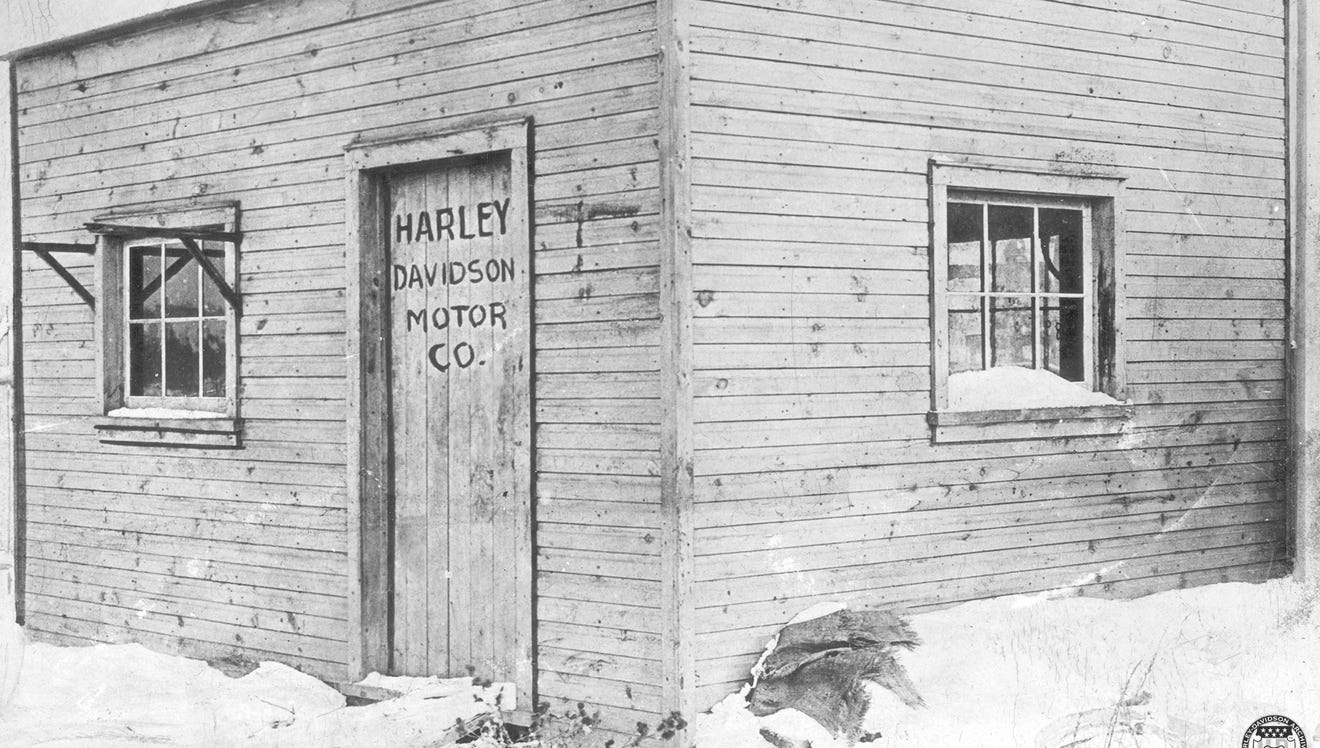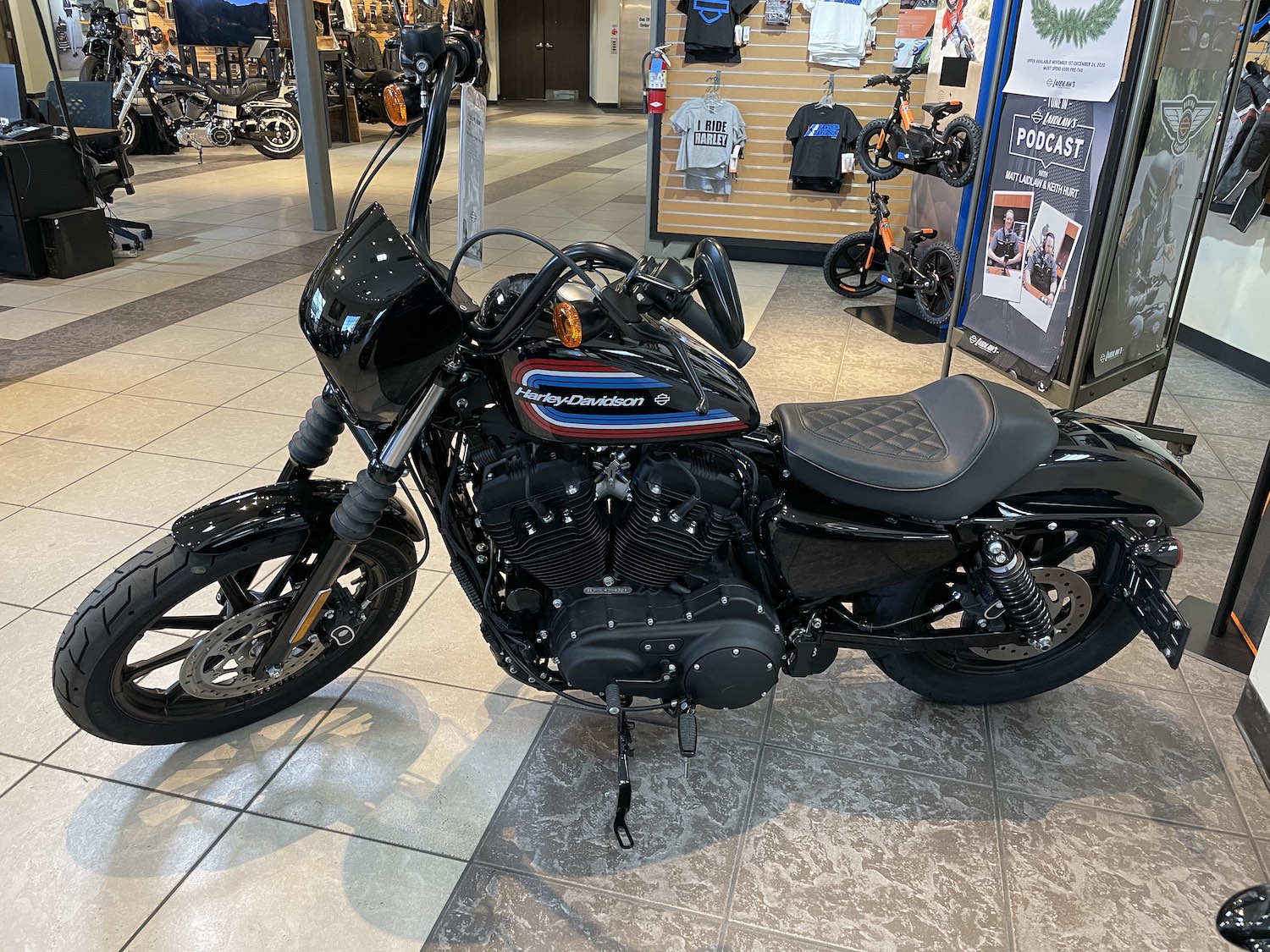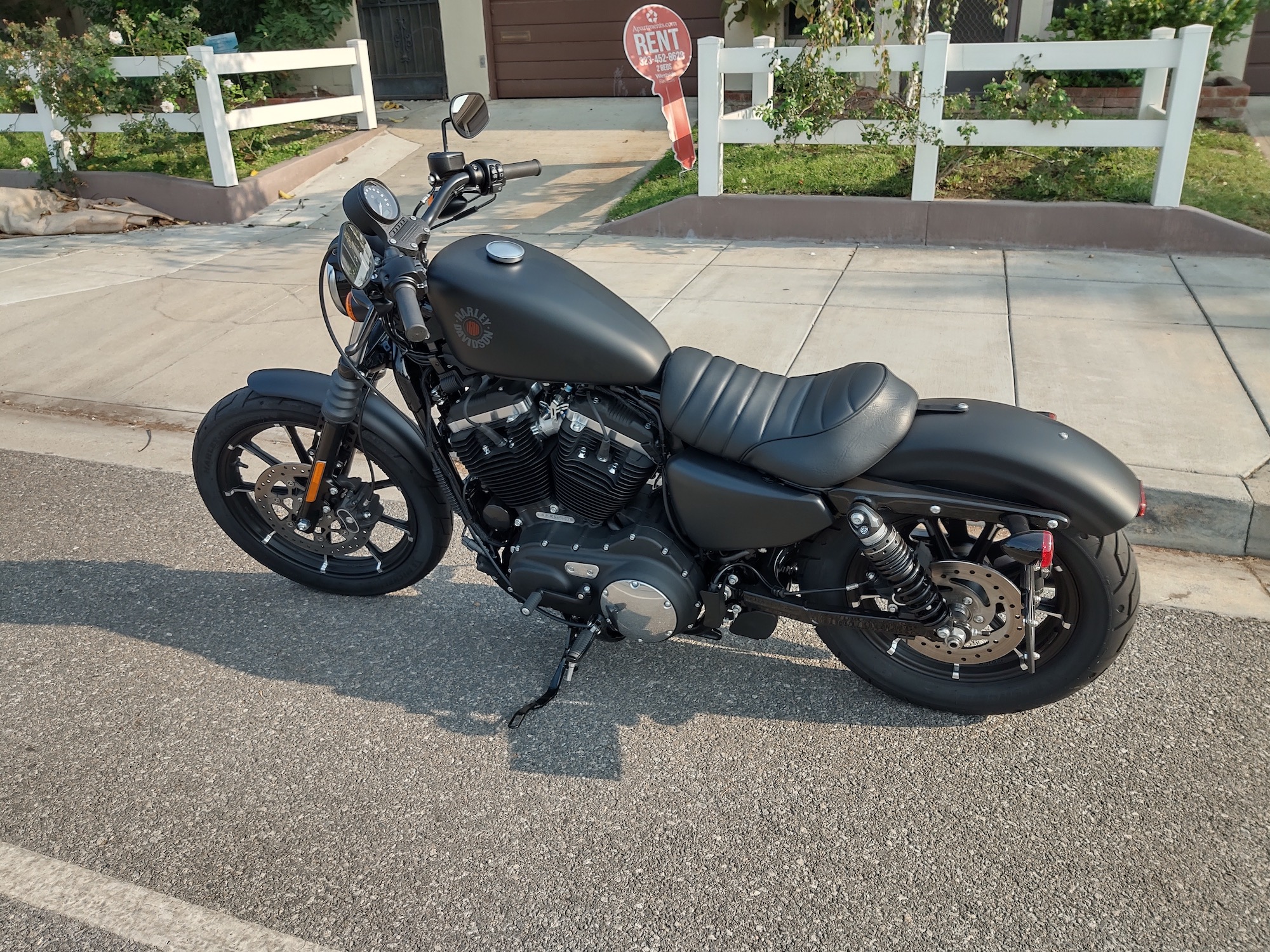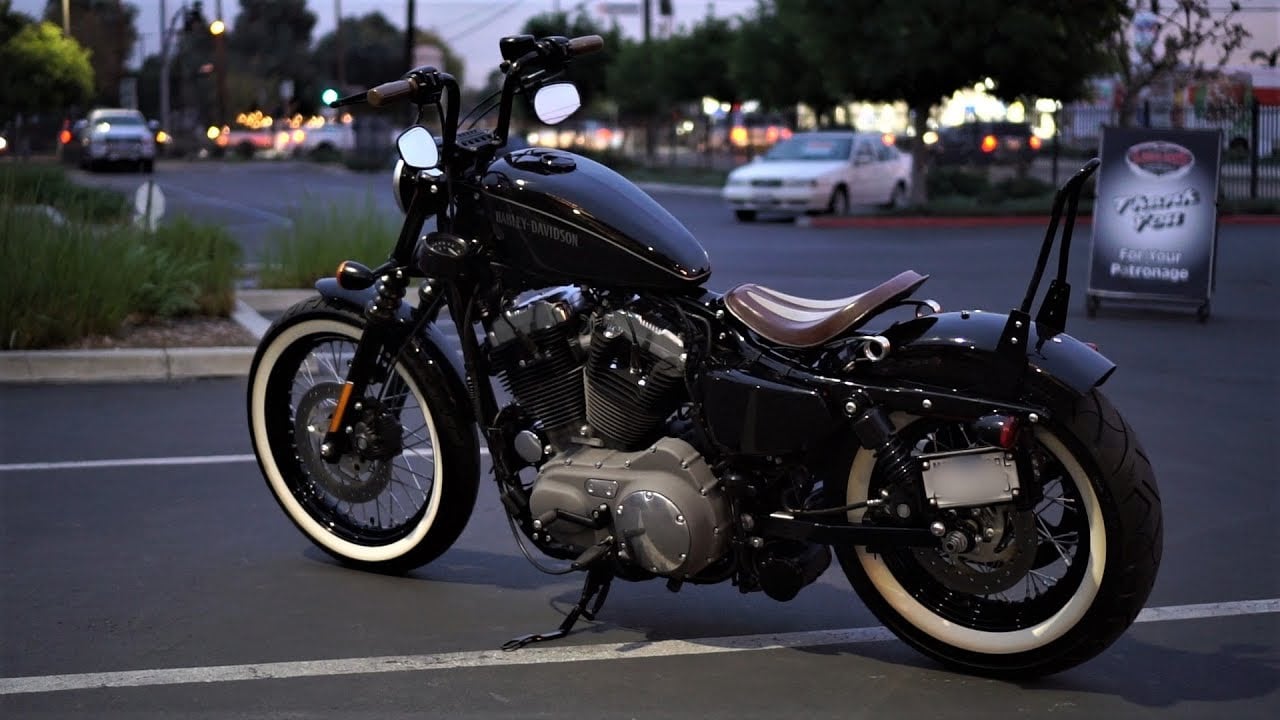67 Years of the Iconic Harley Davidson Sportster
The last of the traditional, old-school American V-twins.
Time never stands still. Here at MONOCHROME, that phrase is particularly relevant. The very purpose of a watch is to measure the continuous advancement of time. And as time marches on, things inevitably change. Car designs are common references to time. Every decade has distinctive styles that help define an era. Cars from the 1920s, 1950s and 1970s help paint a picture of what life was like. Time never stands still. There is an exception, however, from possibly the most stubborn of legendary motorcycle manufacturers, Harley Davidson.
The American icon has been producing its Sportster line since 1957, and notwithstanding incremental changes here and there, today’s bikes are almost shockingly true to the originals. As a bit of a Luddite at heart, these are the perfect bikes for me. Harley Davidson didn’t invent the motorcycle, although it was an early pioneer, with its first bike appearing at the start of the 20th century. The first internal combustion motorcycle was invented in Germany in 1885, the Daimler Reitwagen. American inventor Sylvester Howard Roper even produced a steam-powered bike back in 1869, which is generally recognized as the first American motorcycle. However, you were better off riding an old mule at the time as these were impractical curiosities.
The company wasn’t founded by a Mr Harley Davidson, but by William S. Harley and brothers Arthur and Walter Davidson in Milwaukee, Wisconsin, in 1903. The trio integrated a small 116cc engine into a bicycle frame, but it was slow and unable to climb hills without using the peddles. Not exactly a motorcycle… Yet. The next model was finished in 1904 and much improved with a larger 405cc engine and loop-frame design, and it even placed 4th in a Milwaukee motorcycle race. The following year saw a very limited production run of five, all made in a shed in the Davidsons’ backyard.


In 1906, a bona fide factory was built, and 50 motorcycles were produced, a relatively modest number but a huge leap for the team. The first 45-degree V-Twin appeared in 1907 that had double the power of the earlier singles with a top speed of 60mph. By 1914, the brand was dominant in motorcycle racing and producing over 16,000 bikes annually; by 1920, it was the biggest motorcycle manufacturer in the world. Its main competitor was another American manufacturer, Indian Motorcycles, but that brand fell into bankruptcy in 1953 (although it’s recently been revived). Harley Davidson became a principal supplier of motorcycles to the US Army during both world wars, and civilian production struck gold in the 1950s. Enter the Sportster.

The DNA of the Sportster can be found in the earlier 1952 Model K, which was nigh identical with a smaller 750cc engine. The first Sportsters appeared in 1957 with 883cc and 1,000cc engines, large enough displacements for spirited riding in small, sporty bikes. The main difference was the overhead valve setup used for the Sportsters, improving on the old side valve (or flathead) variants on the Model K. This introduced the famous Ironhead engine that became a Sportster staple for almost 30 years. The transmission was integrated with the engine casting instead of being a separate unit, and it remains that way on Sportsters today. If you want to ride a time capsule, the latest Sportsters provide the same general experience as those 1957 originals.
In the early days, 750cc Sportsters were introduced, and a particular model became the favourite of legendary American daredevil Evel Knievel. If you grew up in the 1970s, his windup stunt cycle was THE toy to have. Knievel didn’t start his career on Harleys, favouring Norton, Triumph, Honda and American Eagle for the first five years. In 1970, he took a new Sportster-based Harley Davidson XR750 to the Lions Drag Strip in Los Angeles and successfully jumped over 13 cars, forever linking him to the brand.
The XR750 remained the bike for Knievel until his last jump in 1977, and major records were set. Near the end of his career, he jumped 133 feet over 14 buses and set the world record for over 20 years. American stuntman Bubba Blackwell surpassed this in the late 1990s when he jumped an XR750 157 feet over 15 buses. Another American stuntman, Doug Danger, jumped 22 cars in 2015, breaking Knievel’s record of 21 cars, and he did this on Knievel’s actual 1972 XR750. You won’t find such old-school machines at today’s X Games, Nitro Circus, and other stunt shows, as modern legends like Rok Bagoros, Travis Pastrana, and Robbie Maddison ride state-of-the-art bikes from KTM, Suzuki and more. But there’s nothing like Evel Knievel launching a Harley Davidson Sportster over an endless row of Greyhound buses in his signature red, white and blue American jumpsuit. There’s only one original, folks.
The XR750 wasn’t just for stunts as it’s also Harley’s most successful racing bike. From 1972 to 2008, it won 29 of 37 AMA Grand National Flat Track Championships, a premier dirt track racing series in the United States. Managed by icons like Dick O’Brien (1957 to 1983), who oversaw the development of the XR750, Harley Davidson was dominant on racing circuits for most of its history, an achievement seemingly forgotten today because of undeserved stereotypes. Notorious motorcycle clubs like the Hells Angels tend to unfairly stain Harley riders with a bad reputation.
Movies also romanticise the “bad boy” image of the brand. In 1953, Marlon Brando played the cool motorcycle gang leader in The Wild One, although he rode a Triumph Thunderbird. His costar, Lee Marvin, rode a Harley Hydra-Glide. Regardless of technicalities here, the movie inspired motorcycle gangs to form throughout the American West Coast, with the majority choosing the Harley brand. This eventually led to the customised chopper that became an iconic symbol when featured in the most famous Harley movie of all time, 1969’s Easy Rider. Starring Peter Fonda and Dennis Hopper, Fonda’s Captain America chopper became one of the most recognised motorcycles in history. Japanese imports from Honda, Kawasaki and others hit the scene in the 1960s and were the antithesis of Harleys – bikes for “nice people”. American consumers quickly figured out just how good Japanese motorcycles were, and Harley’s wild and free image suddenly had a mixed effect on sales. America had gone soft.
The Harley Davidson company has passed through many hands and been on the brink of ruin more than once. The 1970s are most remembered for bad management when American Machine Foundry (AMF) purchased the company in 1969, effectively saving it from financial collapse while simultaneously wrecking its reputation. AMF was known for bowling equipment, among other things, not motorcycles, and in an attempt to slash costs, quality suffered. In a single decade, the brand earned a reputation for unreliability and oil leaks, one that baselessly lingers today. Despite this, the AMF era wasn’t all bad, as achievements like the XR750 and Evolution engine development occurred under its watch. Harley was again sold in 1981 to Willie G. Davidson, grandson of original co-founder William A. Davidson, and a dozen investors for USD 80 million. Willie took control of design and produced several classics, including the Low Rider and Super Glide, but the new owners also finished the most important development started by AMF, the Evolution engine.


Almost comically known as the Blockhead, the Evolution (or Evo) debuted in 1984 in a 1,340cc variant for the larger V-twin bikes, replacing the ageing Shovelhead engines. However, its biggest impact occurred in 1986. After 29 years, the Sportster Ironhead engines were replaced by 883cc and 1,200cc Evolution engines. The classic Harley rumble that people associate with the bikes is likely from a Sportster Evo, and nothing else sounds like it. A Fender Stratocaster on wheels. An upgrade from the old Ironhead was the switch from cast iron to all-aluminium for the heads and cylinders, reducing weight while also improving cooling and overall reliability.
There were only three key changes to the Sportster Evo engines since 1986. The transmission had four speeds until 1991, when it upgraded to five (never gaining a contemporary sixth). Following the 2006 model year, carburettors were replaced with fuel injection, improving efficiency and emissions standards. Two years earlier, Evo engines also gained rubber mounts, reducing vibrations compared to a direct mount on the steel frame. This was a big deal for rider comfort, transforming bikes from jackhammers on wheels to a mellower dryer full of shoes. Today’s Sportsters are still plenty vibrational, and I wouldn’t have it any other way. If you want smooth and quiet, buy a Honda (and be a nice person). If you look at today’s Iron 883, a name ironically recalling the old Ironhead engine, it’s very similar to the original 883 from 1957. Air-cooled, pushrods and overhead valve configuration, along with a total lack of technology. You won’t find rider modes, ride-by-wire or fancy entertainment systems. These remain analogue bikes in a digital age. If it were up to me, they’d still have carburettors.

Because Sportsters have such a long history, they’re arguably the most customisable motorcycles in the world. In fact, you can build an entire “Sportster” from scratch, solely from aftermarket parts. That’s just crazy. Harley also has its own performance division called Screamin’ Eagle, which sells parts to improve both power and sound without compromising the warranty. The company began offering custom tweaks direct from the factory as well, most notably with the introduction of a blacked-out aesthetic in 2007. This debuted with the 1200cc Nightster (Sportster) that shed the traditional shiny chrome for black and deep greys. It wasn’t the first Harley to try this as a couple of the bigger bikes toyed with the idea, such as the Softail Night Train in 1999. It also wasn’t an overnight success as separating chrome from Harley seemed sacrilegious, but the Nightster soon resonated with a younger generation and changed Harley forever. Today, all Sportsters and most of Harley’s portfolio are blacked out to some degree.

There are only three Sportsters left in Harley’s 2021 lineup after the 1200cc Roadster was dropped this year. Introduced in 2016, the Roadster is the most performance-oriented Sportster with a higher stance, low bars, more power, inverted front forks and dual disk brakes. It’s unlike any other Sportster and in a class of its own, and it’s the Harley I’m lucky enough to have parked in my garage. The model was also the most expensive Sportster and had more of a cafe? racer vibe than traditional cruiser, which made it less popular than the others. The Evo engines no longer meet Europe’s strict emissions standards, and Harley isn’t known to continue models just for North America. Time never stands still, and we’re facing the end of an era, one that spanned 67 years.

What’s the future? The more environmentally friendly Milwaukee-Eight engines launched in 2016 and are only the third ground-up Harley big twins developed in over 80 years. They’re powerful, refined and now dominate the Softail and Touring lines, leaving the old Evo engines to an endangered few Sportsters. The 150HP, 1,250cc Revolution Max is a new liquid-cooled, 60-degree V-twin for a new generation of Harleys, debuting in the 2021 Pan America adventure bike. A variation of this engine will likely trickle down to the Sportsters, assuming the line isn’t replaced entirely. An all-electric sportbike, the LiveWire, represents an inevitable future. Its Revelation PM motor makes it the fastest accelerating Harley ever, but the quiet ride, realistic range of 100 miles or less, high price and lengthy charging times currently limit its appeal. Of course, that will improve over time. But the old-school Sportster, bikes that make you feel like you’re back in the 1950s, represent the last of the traditional brand. When they’re gone, a big piece of Harley will die with them.
















16 responses
Myth talk.
in the last 20 years the Sportster was already digitalized using ECU/EFI ignition and carburation control, just stylishly hidden, and the cables to accomodate grew into looms that were visible from far.
It’s an antique and for good reason it isn’t compliant with modern world requirements.
the purpose to compete successfully against the british armada was a 100% fail until racing organisations tweaked the regulations against fair international treatment to overcome the period of british, italian and japanese leadership on the domestic racing scene. Now there’s a new domestic competitor that’s beating HD in all performance classes.
I like the sportster too, don’t get me wrong, I love classic, oldtimers, but the time has come. done – let’s get on.
HD needs to show us for what it stands in the near future (already today in some places) where gas-powered machines are prohibited and gasoline $$ raise beyond $2 per litre up to targeted $6.
Pedelecs? E-bicycles – LOL. China has the massive lead on that, and some european high-end specialists.
@Carlos When he wrote America had gone soft, I read America had become informed ! Consumers can be romanced ,but most will pick the better product given the choice.
To the author, your 2018 1200 Roadster, in a class of its own, as it might be, is it stock ? I can’t find one online with that air cleaner and as murdered out as yours is ! Please let me know ! Thank you !
@Ray It’s a fairly stock bike, but does have a few mods. The air cleaner is an Arlen Ness Monster Sucker and the exhaust is a pair of Screamin Eagle Street Cannons with black heat shields (stock headers). The black timer cover (#5) is from an older Nightster. The stock air cleaner and timer covers are medium grey, so these couple of things make a real visual difference. The brake and clutch levers are also black – stock are silver. If you’re wondering, I also tuned it with Harley’s pro street tuner to accommodate the new air cleaner and exhaust.
Eric, thank you for the reply ! I was beginning to wonder if they only made a hand full of these and I would never see one for sale ! You should have been on the design team as your rendition is the best looking I have seen ! I think it looks so factory as if they had actually done a special edition . Great job ! Have a great summer and ride safe !
Thanks Ray, much appreciated! And stay safe
Real riders ride BMW and we can read!
Someone in our street has one, probably the most efficient bike in the world seems to pretty much convert all of the energy in petrol into noise.
Awesome article the best Sportster history I’ve seen.
I’ll KEEP the old reliable that I can work on myself
The sporty was my first Harley in 70 and looking to be my last Harley as iam styling wire my 08 1200 xl custom to be my last iam 69 years young and very attached to my 08 looks like I’ll be going down with the Ship
@Stewart Thanks, much appreciated!
2007 XL1200R in black cherry, with laced wheels. Best looking Sporster ever!
I love this article but I have to point out that the first production Harley Davidsons to get the blacked out engine treatment was the 1981 Harley Davidson FXB Sturgis and it was introduced again in the Sportster lineup in 2002 with the 883R and then again in 2003 with the Harley Davidson Roadster. I just feel like people didn’t notice until the Nightster came out (the nighster name is important and will be mentioned in the bottom paragraph).
I have a fairly modified 2018 Forty Eight. When I say fairly I may be understating it. I have build everything from the brakes (brembo radial calipers with brackets to fit them and larger brembo floating rotors, xr1200 master cylinder, braided lines) to the clutch (barnett plates, diaphram spring and billet pressure plate, cable and 1fngr easy pull clutch and brake levers) to the suspension (Progressive adjustable monotube cartridge fork internals, 13 inch adjustable 490 sport series shocks, daytona steering damper) to the motor (s&s 1250 jugs and forged flat top pistons and tear drop air cleaner, feuling cams, valve springs, lifters and injectors, hammer performance push rods, buell bronze oil pump gear, stainless bassani road rage 3 2 into 1, v&h fp3 soon to be replaced with a thundermax ECM, Dynatek EFI ignition coil, Screamin Eagle fat plug wires and plugs, TMF chain conversion) to the body (carbon fiber front and rear fenders and side panels, with all the engine cases being replaced with HD flat black upper rockers, gloss black lower rockers, pushrod tubes, lifter covers, chopped cam case, primary case, derby cover, inspection cover) 10 inch mx tbars, saddlemen step up seat, HD mid controls, HD lcd master cylinder fuel gauge, lcd oil temp/level dipstick, tach with analog speedo that also has a fuel gauge, miles to empty, gear indicator and can be customized with over 600 colours for the tach needle, backround and analog section all independently so the customization is never ending for the tach. I am sure there is plenty of stuff I am missing, and I plan on eventually doing a nice inverted fork setup with dual discs and radial monoblock calipers with a Buell XB12/ Harley Davidson XR1200 crankshaft, balanced CP Carrillo rods and pistons and port/polish with some bigger intake/exhaust valves and a bigger throttle. The absolute last mod MIGHT be a trask turbo if 120+hp in a lightened Sportster with awesome suspension and brakes isn’t enough fun for me? I absolutely love the Sportster platform and even when the bike was bone stock it was quite and not very fast and the “premium emulsion shocks” weren’t very premium but damn it was still a blast to ride. I own and have owned many bikes, but instead of trading/selling the Sportster for another bike I decided to let it grow with me and I will never get rid of it.
I am looking forward to July 13th to see if the new bike released is the Sportster replacement which is what is appears to be with the HD site stating “From Evolution to Revolution. Prepare for a level of power and performance that has surpassed all expectations. ” which sure sounds like a Sportster replacemen to me and with LOTS of potential! As for the Nightster name, Harley Davidson recently reapplied the trademark in Europe and North America to the “Nightster” name again and also for the “48X”, so I think we know two of the new Sportster models to come. I wonder if the 1250 will replace the 1200 and the 975 to replace the 883? It would make sense, and the HD site is boasting about performance on the new model which would be really cool if they put the Sport back in Sportster. The talk is that the 150hp/90tq 1250 would be bumped down to 120hp and over 100tq which would make for one hell of a Sportster especially since the motors are stressed members and help make the weight low (the hulkingly huge Pan America only weighs 550lbs) so it isn’t crazy to think we may see a sub 500lb Sporty…..Sporty hahaha
Time will tell! July 13th
I am really looking forward to seeing Harley Davidson grow in many ways!
The tanks are too f……. small. A coffee shop yuppie bike. A great bike ruined.
You left out the most iconic Sportster of all time. Then Came Bronson